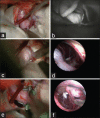Role of endoscopy in multi-modality monitoring during aneurysm surgery: A single center experience with 175 consecutive unruptured aneurysms
- PMID: 25767585
- PMCID: PMC4352638
- DOI: 10.4103/1793-5482.151518
Role of endoscopy in multi-modality monitoring during aneurysm surgery: A single center experience with 175 consecutive unruptured aneurysms
Abstract
Objective and background: Unruptured aneurysm surgery is a challenge to all vascular neurosurgeons as the patient is asymptomatic and no even slight neurological deficits should be expected postoperatively. To this aim, multi-modality checking of the vessels during the surgery is highly recommended to assure of the patency of the parent and perforator arteries next to an aneurysm. In this paper, we present our experience in the last 1.5 years with emphasis on the role of endoscope assisted microsurgery.
Methods: One hundred and seventy-five patients with unruptured intracranial aneurysms were operated in our institute in the last 1½ years. All patients underwent endoscope assisted microsurgery with pre- and post-clipping indocyanine green angiography. In selected cases, motor evoked potential monitoring was implemented.
Results: No mortality was observed in this period, and only 6 patients (3.4%) suffered new permanent neurological deficits postoperatively. Our illustrative cases show how endoscopy may help the surgeon to visualize hidden vessels behind and medial to an aneurysm.
Conclusions: Our results indicated that multi-modality monitoring during unruptured aneurysm surgeries is associated with excellent outcome. Endoscope is able to show blind corners during aneurysm surgery which cannot be routinely observed with microscope and its application in aneurysm surgery assists the surgeon to make certain of complete neck clipping and preservation of perforating arteries around the aneurysm.
Keywords: Brain; clipping; endoscopy; monitoring; unruptured aneurysm.
Conflict of interest statement
Figures


Similar articles
-
Predictive Value of Motor Evoked Potential Monitoring during Surgery of Unruptured Anterior Circulation Cerebral Aneurysms.Asian J Neurosurg. 2017 Oct-Dec;12(4):644-647. doi: 10.4103/ajns.AJNS_135_14. Asian J Neurosurg. 2017. PMID: 29114276 Free PMC article.
-
Endoscope-assisted microneurosurgery for anterior circulation aneurysms using the angle-type rigid endoscope over a 3-year period.Childs Nerv Syst. 2004 Nov;20(11-12):811-5. doi: 10.1007/s00381-004-0935-1. Epub 2004 Jun 23. Childs Nerv Syst. 2004. PMID: 15221249 Clinical Trial.
-
Endoscopic indocyanine green video angiography in aneurysm surgery: an innovative method for intraoperative assessment of blood flow in vasculature hidden from microscopic view.J Neurosurg. 2012 Aug;117(2):302-8. doi: 10.3171/2012.5.JNS112300. Epub 2012 Jun 8. J Neurosurg. 2012. PMID: 22680246
-
The Clinical Importance of Perforator Preservation in Intracranial Aneurysm Surgery: An Overview with a Review of the Literature.Chonnam Med J. 2017 Jan;53(1):47-55. doi: 10.4068/cmj.2017.53.1.47. Epub 2017 Jan 25. Chonnam Med J. 2017. PMID: 28184338 Free PMC article. Review.
-
Selection of cerebral aneurysms for treatment using Guglielmi detachable coils: the preliminary University of Illinois at Chicago experience.Neurosurgery. 1998 Dec;43(6):1281-95; discussion 1296-7. doi: 10.1097/00006123-199812000-00011. Neurosurgery. 1998. PMID: 9848841 Review.
Cited by
-
State-of-art in surgical treatment of dissecting posterior circulation intracranial aneurysms.Neurosurg Rev. 2018 Jan;41(1):31-45. doi: 10.1007/s10143-016-0749-0. Epub 2016 May 24. Neurosurg Rev. 2018. PMID: 27215913 Review.
-
Keyhole clipping of a low-lying basilar apex aneurysm without posterior clinoidectomy utilizing endoscopic indocyanine green video angiography.Surg Neurol Int. 2020 Feb 28;11:31. doi: 10.25259/SNI_582_2019. eCollection 2020. Surg Neurol Int. 2020. PMID: 32257557 Free PMC article.
-
Clipping of anterior circulation aneurysms using fully endoscopic-assisted minimally invasive keyhole craniotomy: a clinical study and analysis.Neurosurg Rev. 2025 Mar 8;48(1):288. doi: 10.1007/s10143-025-03226-5. Neurosurg Rev. 2025. PMID: 40056234 Free PMC article.
-
Use of our Protocol of Multimodality Tools to Aid in the Safe Microsurgical Clipping of Unruptured Anterior Circulation Aneurysms.Asian J Neurosurg. 2019 Jul-Sep;14(3):773-779. doi: 10.4103/ajns.AJNS_65_19. Asian J Neurosurg. 2019. PMID: 31497101 Free PMC article.
-
Intraoperative Use of Endoscope, a Valuable, Adjunctive Tool for the Surgical Management of Anterior Communicating Artery Aneurysm Surgery: Our Institutional Experience.Asian J Neurosurg. 2020 May 29;15(2):338-343. doi: 10.4103/ajns.AJNS_359_19. eCollection 2020 Apr-Jun. Asian J Neurosurg. 2020. PMID: 32656129 Free PMC article.
References
-
- Lin N, Cahill KS, Frerichs KU, Friedlander RM, Claus EB. Treatment of ruptured and unruptured cerebral aneurysms in the USA: A paradigm shift. J Neurointerv Surg. 2012;4:182–9. - PubMed
-
- Aydin Y, Cavusoglu H, Kahyaoglu O, Müslüman AM, Yilmaz A, Türkmenoglu ON, et al. Clip ligation of unruptured intracranial aneurysms: A prospective midterm outcome study. Acta Neurochir (Wien) 2012;154:1135–44. - PubMed
-
- Motoyama Y, Kawaguchi M, Yamada S, Nakagawa I, Nishimura F, Hironaka Y, et al. Evaluation of combined use of transcranial and direct cortical motor evoked potential monitoring during unruptured aneurysm surgery. Neurol Med Chir (Tokyo) 2011;51:15–22. - PubMed
-
- Oda J, Kato Y, Chen SF, Sodhiya P, Watabe T, Imizu S, et al. Intraoperative near-infrared indocyanine green-videoangiography (ICG-VA) and graphic analysis of fluorescence intensity in cerebral aneurysm surgery. J Clin Neurosci. 2011;18:1097–100. - PubMed
LinkOut - more resources
Full Text Sources
Other Literature Sources

